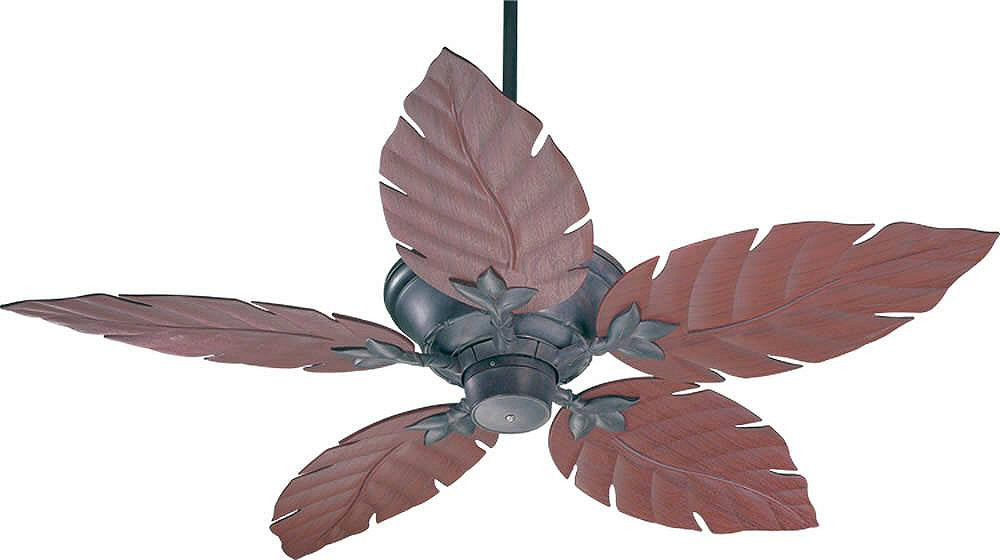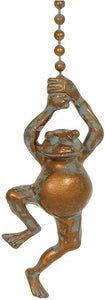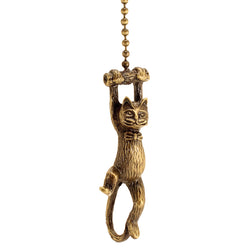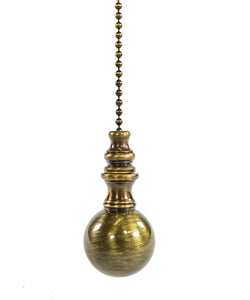Quorum 52"W Monaco Patio Indoor/Outdoor 5-Blade Patio Ceiling Fan Toasted Sienna

52"W Monaco Patio Indoor/Outdoor 5-Blade Patio Ceiling Fan Toasted Sienna
This Monaco Patio Ceiling Fan, finished in attractive Toasted Sienna, is the perfect touch to complement your patio area. With a UL listing for both dry and wet locations, this fan is versatile and can be installed inside or outside. This 5-blade ceiling fan will create a breeze capable of keeping you cool on those hot summer days.- Toasted Sienna Finish
- 5 x Rosewood Blades
- 5 blades with a 52" total blade-span and 14-degree blade pitch
- Overall fan height: 16.73"
- Height from ceiling to bottom of blades: 13.58"
- Housing Width: 13"
- Motor Size: 188mm x 15mm
- Features a 16-Pole Motor
- Canopy Height: 5.25"
- Detachable Switch Cup for optional light kit installation (light kit not included)
- Skirted Blade Arms
- Suitable for outdoor/patio use
- Three unique speed settings
- Amps: 0.52 on High, 0.38 on Medium, 0.26 on Low
- Watts: 65 on High, 38 on Medium, 18 on Low
- Revolutions per Minute: 170 RPM on High, 120 RPM on Medium, 78 RPM on Low
- Includes a pull-chain switch with High/Medium/Low/Off settings
- Fan may be run in reverse using a switch on the fan motor
- Includes 80" of Lead Wire
- Limited Lifetime motor warranty
- Does NOT include a remote control
- Compatible with the 7-3000 and 7-1401-0 Remote Controls from Quorum (not included)
- Includes 4" and 6" downrods
- Part of the Monaco Patio Collection by Quorum International
- UL Listed for wet/outdoor locations
- Weight: 27 lbs
|
|
|||||
| Revolution Speed (RPM - Revolutions per Minute) | Air Flow (CFM - Cubic Feet of Air Flow per Minute) | Electricity (Watts - Electricity used not including any Lights) | Efficiency (CFM/Watt - Cubic Feet of Air Flow per Minute per Watt used - higher is better) | AMPs (Amperage of Electrical Current used) | |
| HIGH Speed | 170 | 5055 | 67 | 75 | 0.52 |
| MEDIUM Speed | 120 | 38 | 0.38 | ||
| LOW Speed | 78 | 18 | 0.26 | ||
| Efficiency is the cubic feet of air that can be moved in one minute if the fan were to use 1 watt of electricity, and can be used to compare energy-efficiency among different ceiling fans. The higher this number the more energy-efficient the fan is. This ceiling fan's airflow efficiency is about average, compared to fans with a 52" blade span. By comparison, other regular-sized ceiling fans with a 52" blade span typically provide an airflow efficiency ranging from 71 to 100 cubic feet per minute per watt. | |||||
Elegant Design and Style
The 52"W Monaco Patio Indoor/Outdoor 5-Blade Patio Ceiling Fan in Toasted Sienna brings a touch of elegance to any space. Its unique design features five rosewood blades shaped like leaves, adding a natural and sophisticated aesthetic to your décor. The toasted sienna finish complements various styles, from rustic to contemporary, making it a versatile addition to your home.
Superior Features and Benefits
This ceiling fan is not just about looks; it’s packed with features designed for optimal performance. With a UL listing for both dry and wet locations, it can be installed indoors or outdoors, offering flexibility in placement. The fan has a total blade span of 52 inches and a 14-degree blade pitch, ensuring efficient air circulation to keep you cool during hot summer days.
The Monaco Patio Ceiling Fan is equipped with a powerful 16-pole motor that provides three unique speed settings: high, medium, and low. It operates at 170 RPM on high, 120 RPM on medium, and 78 RPM on low, with corresponding airflow and energy efficiency ratings. The fan includes a pull-chain switch for easy control and can be run in reverse using a switch on the motor, perfect for year-round use.
Ideal Locations and Themes
Thanks to its weather-resistant construction, this ceiling fan is ideal for patios, porches, and other outdoor living spaces. It also fits perfectly in indoor areas like living rooms, bedrooms, and sunrooms. Its natural leaf blade design makes it an excellent choice for tropical, coastal, or nature-inspired themes. Whether you’re hosting a summer barbecue or simply relaxing indoors, this fan enhances the ambiance while providing a refreshing breeze.
Energy Efficiency and Performance
Energy efficiency is a key feature of the Monaco Patio Ceiling Fan. On high speed, it consumes 67 watts of electricity, delivering an impressive airflow of 5055 CFM (Cubic Feet per Minute). This translates to an efficiency rating of 75 CFM/Watt, making it an eco-friendly option for your home. The fan's performance ensures you stay comfortable without significantly increasing your energy bills.
Order Now
Enhance your living space with the stylish and functional 52"W Monaco Patio Indoor/Outdoor 5-Blade Patio Ceiling Fan in Toasted Sienna. Its elegant design, superior features, and energy-efficient performance make it a must-have addition to any home. Order now and enjoy a cool, comfortable environment all year round!

What is an Ceiling Fan?
 A ceiling fan is a fairly large ceiling-mounted fan which can rotate clockwise or anticlockwise. In one direction the fan blows air downward, while in the other it draws air upwards. Some fans come equipped with a light fixture to double as a central light. The fan is a hardwired fixtures so has to be installed electrically. Typically it is used with a wall switch or remote control. Ceiling fans can help keep you cool in summer and also warmer in winter by circulating the air.
A ceiling fan is a fairly large ceiling-mounted fan which can rotate clockwise or anticlockwise. In one direction the fan blows air downward, while in the other it draws air upwards. Some fans come equipped with a light fixture to double as a central light. The fan is a hardwired fixtures so has to be installed electrically. Typically it is used with a wall switch or remote control. Ceiling fans can help keep you cool in summer and also warmer in winter by circulating the air.
Ceiling Fan Benefits
- Circulates air for healthier breathing.
- Reversible direction for summer/winter.
- Blows air onto bodies for direct cooling.
- Draws hot air upwards for ambient cooling.
- Optional speeds for varying effect.
- May add to lighting (if light is included or addedd).
- Saves on electrical heating bills.
- Keeps rooms fresher and helps remove odors.
- Provides a gentle breeze over a bed or chair.
- Usually can be manually (pull chain) or wall (switch) operated.
- Helps to remove or distribute hot rising air.
Casual Style
Informal and comfortable, this relaxed style accentuates an airy and unpretentious living space, evoking the feeling of a permanent beach cottage vacation. Casual Lighting uses clean and simple lines, subtle curves, natural textures, and decorative glass for a subtle elegance that doesn’t overwhelm the senses.
For which rooms?
A ceiling fan needs enough headroom, so is ideal over some furniture such as a couch, seating area or bed. See hugger fans for maximizing headroom. Fans are most often used in living rooms, family rooms and bedrooms, where people might be dwelling for a longer period of time.
Placement/Layering
A fan is best positioned either centrally in the room or above a main seating or sleeping area. If the fan has a light it can help to light the room. We recommend adding either wall lights or some lamps to fill out the space.
Mounts to the Ceiling
Attaches to a ceiling. The ceiling should be flat, unless the fan supports sloped/vaulted ceilings. A small canopy will conceal the electrical installation.
Installed by an Electrician
An electrician or person with electrical installation knowledge will need to permanently wire the ceiling fan into the building's electrical supply.
Resources
Learn how to choose ceiling fans with our Energy Star lighting
We've shopped for you!
You're getting the the lowest prices, guaranteed!
Thousands of items are on sale every day. Plus you're tax-free unless you live in Wisconsin.
Want a different price? Contact us for a personalized quote.
Safely checkout with our world-class encryption.
Trusted by over 100,000 customers, your private and payment data is secure and will not be shared.
We accept Visa, Mastercard, Discover and Paypal. Credit cards can also be processed through Paypal.
Spend $49.00 to get Free Shipping (contiguous USA).
Most other items ship for $9 in 1-3 business days (contiguous USA). QuickShip items ship out the next business day.
Depending on your location, shipments take on average 3-5 business days or up to 7-10 from coast to coast. We ship from multiple locations.
You will receive tracking numbers by email when your items ship out, via Fedex, UPS or USPS.
You'll be able to track the packages online or on our site.
You can also talk to our team of experts at any time, or Live Chat.
Enjoy 30 days for easy returns. See our return policy for details.
We replace breakages/damages/missing parts etc for free.
Every item is covered under our extended 1-year warranty.





